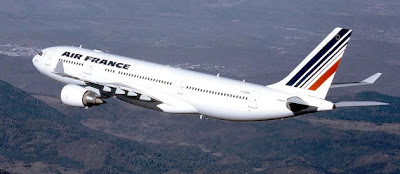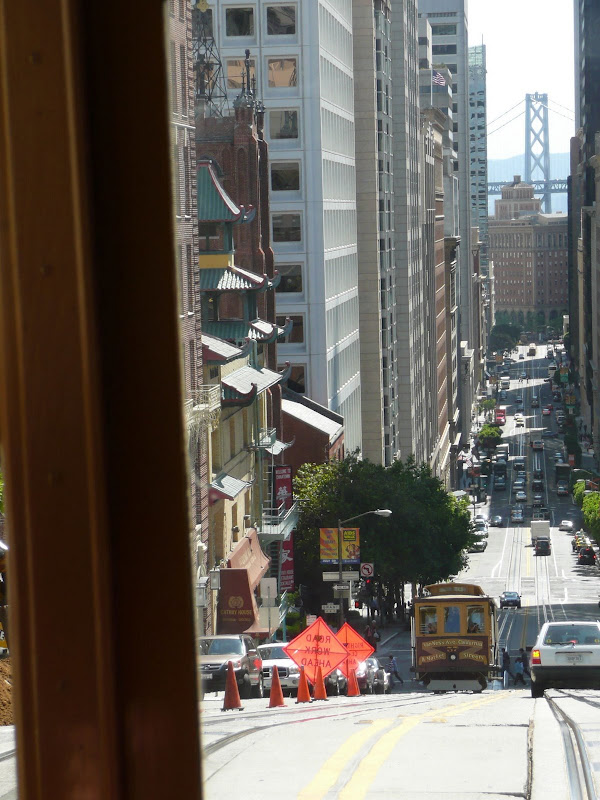The Cable Car, the only monument in the world mobile  Thursday, May 22, 2008, 10:00
Thursday, May 22, 2008, 10:00 A short trip by bus, via
Franklin Street, leads us to cross between Van Ness Avenue and California Street. If you want to "see" yourself, and once again I thank the cameras of Google ™
, follow this link
. Look, in the shadows, there is one who is there to stop! But what exactly does it then, you say? Do not ask questions, and climb! And if there is no room inside, it does not matter, however, there are the steps, it's even better for what will follow, trust me.
course, and you can imagine, I want to talk today a must for tourists visiting San Francisco, a real attraction is the famous Cable Car. You've already seen in a previous article where I did discover
the streets of San Francisco .
The descent of California Street is worth seeing. Set aside fifteen minutes during your stay. This is really a minimum, and you will not regret it! These cable trams are true museum pieces. And what Strikingly, once inside, it's the archaic system.
Another surprising detail is the smell of burnt wood that emerges primarily under arrest. In fact, if you want, let me explain briefly how it works.
First the idea. We are in 1869, Andrew Smith Hallidie assists, dumbfounded, at a traffic accident. It rained, the cobblestone streets sloping are very slippery. A hitch has just reversed back. The five horses towing the dead, crushed under the heavy load. Hallidie's father, an Englishman, had filed a patent for the manufacture of cables. This gives his son an idea that will first be tested. He has already served himself such cables for the construction of a suspension bridge over the Sacramento River. And he also found another use in towing the cars of ore in an underground mine.
August 2, 1873, he launched his funicular / cable car on Nob Hill Hill, from the junction between Clay Street and Jones Street. And it is conclusive, since the beginning of September, we begin to build this line, so to replace animal power by cables buried under the pavement. Then the lines of Sutter (1877) and California (1878) are put into operation. And it will allow the extension of the city on the hills and the construction of other lines. Thus was born the cable-drawn tram, ie Cable car on rail, in English.
technique? An endless cable buried under the street level, a pulley at each end, top and bottom, with a single motor which drives the cable continuously at a constant speed of about 15 kilometers per hour. The vehicles, guided by two rails, grip the cable with a clamp to mount the slopes or are coasting to descend.
The mechanic called rightly
gripman , release the cable stops. It operates of course the brakes are actually made of wooden blocks, which wear out very quickly, of course. On this line, arriving at the terminal, he descends from his cockpit, and passes the other end of the car and on the other side of the track with a simple switch and here we go again! On the only other remaining lines, the cars have a cockpit. They are returned by hand, using the turntables! Childish, after all, right?
This system began to be replaced in 1892, when the introduction of electric streetcars, powered by overhead cables. During the earthquake of 1906, most lines of cable cars were destroyed and were replaced by electric trams. then by bus. In 1947, the then mayor is trying to permanently delete this type of transport.
But under the aegis of Friedel Klussmann, then created a committee soon to ask for backup. An overwhelming vote takes place that requires the city to maintain and continue to exploit the Powell line. This woman has succeeded through perseverance, to keep three lines, because they were already part of the historical heritage of the city. The set has been restored and revised in the 1980s. And that is our greatest pleasure!
For the record, every year is organized a contest between
gripmans (including a woman, knowing that the job is very physical) to see which does best jingle bell sound Cable car! Folklore when you hold us!
Also note that the Cable car operates daily between 6:30 and 23:30 and that its frequency is about 12 minutes. You should know that in practice, only tourists pass through this means of transport, which is not the fastest nor the cheapest. It is probably for these reasons that only three lines remain. Furthermore it that connects Van Ness Avenue at Market Street, there Powwell / Hyde and Powell / Mason (see detail
lines).
Admit that we have done well to make this little journey still impressive in one of the steep streets of San Francisco . I even just forgot to tell you what we've seen another on the way ...
and Grace Cathedral Nob Hill ,
Fairmont Hotel ,
Chinatown, and to complete all the skyscrapers of the Financial District
.
It is half past ten, and we find our bus awaited us a few blocks away. We continue? ______________________________________________________________________________
Want more? You can find more information and many details on the selection of sites,
in English, sorry :









































